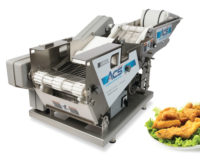Preparing for The Unthinkable
As terrorism rears its ugly head throughout the world, meat and poultry plants must take further steps to protect their facilities, products, and people.
Safeguarding meat and poultry processing and distribution facilities, historically a key priority of plant operators, has taken on greater importance since the 2001 terrorist attacks.
President George W. Bush signed into law the Public Health Security and Bioterrorism Preparedness and Response Act of 2002 nine months after the events of 9/11. The legislation , among its many provisions, enhances the ability of the U.S. Department of Agriculture’s (USDA) Food Safety and Inspection Service (FSIS) to inspect and insure the safety of meat and poultry.
While FSIS provides security suggestions to food processors, it is in essence preaching to a willing congregation. That’s because meat industry trade groups have been furnishing guidelines for securing sites and operations to their members for years, and many plants already are adhering to the FSIS recommendations.
A wakeup call
Still, the legislation serves as a wakeup call for processors who might be getting complacent in upgrading their safeguards, or need to be educated on newer threats.
“Security for many plants before 9/11 hinged on ensuring that employees were not stealing products, or taking steps to prevent individuals from breaking into facilities,” says Jay Wenther, assistant executive director of the Elizabethtown, PA-based American Association of Meat Processors (AAMP). “Now they must consider the best ways to thwart the intentional contamination of food, so security has taken on a whole new meaning.”
AAMP, which represents about 1,400 smaller meat processors, conducts seminars on food security and produces materials that recommend safeguards. The association recently distributed a 150-page “Crisis Management & Food Security Training Manual” to attendees of conferences it recently conducted in Michigan.
The manual is intended to provide lower-volume processors with a basic understanding of food security and stress the importance of a viable safety program.
It outlines steps companies can take to help prevent intentional contamination with a focus on assessing and managing risk; performing crisis management; implementing a recall program; and responding to and recovering from security breaches. Security checklists also are included in the materials.
“There is not one plain, simple idea that works best for everybody, so it is important to get out all the information so processors can start thinking again about issues,” Wenther notes.
A variety of considerations
Indeed, smaller family-owned and operated businesses with a workforce that often consists of friends and relatives — and larger plants with frequent employee turnover—will have different security considerations. The bigger facilities, for instance, typically will need additional plant supervision and controls, and should assign only the most trusted employees to work in the areas most vulnerable to breaches, AAMP recommends.
While much of the AAMP manual is tailored for Michigan processors, the association plans to add more general information so it can be distributed nationally. The USDA, National Food Processing Association, Department of Homeland Security, and FSIS furnished many of the materials.
“It is important to have this kind of a resource because we can’t spend two months trying to develop data if an event were to trigger an immediate need for safety information,” Wenther says.
NMA tools
Bioterrorism-related resource guides also are being distributed by the Oakland, CA-based National Meat Association (NMA). NMA’s “The Key to Managing a Business Crisis,” produced shortly after 9/1l, includes details on ways to handle anthrax and other biological agent threats, as well as methods for safeguarding laboratories and ingredients. Information suppliers include the Centers for Disease Control and Prevention and the U.S. Environmental Protection Agency.
“Instead of just focusing on cross-contamination issues, the industry now is looking more at the effect of contamination that isn’t occurring naturally,” says Jeremy Russell, NMA director of information and legislative issues.
Because much of the Bioterrorism Act deals with higher-level coordination among government agencies that are involved in regulating the food supply, most meat processors are not directly affected by most of the legislation, analysts say. Skip Seward, vice president of regulatory affairs for the Washington, DC-based American Meat Institute (AMI), notes that the act’s strongest impact is on facilities regulated by the U.S. Food and Drug Administration (FDA). Those companies must adhere to such mandates as giving the agency notification of their intent to import raw materials.
Similar to other industry organizations, AMI in advance of the act developed its own best practices for food security, and many of the guidelines are the basis for the FSIS’ recommendations. The agency suggests to processors ways to develop a plan to prevent and manage risk; train employees and screen potential hires; secure the plant; monitor the production system; and report suspicious activity.
“Meat and poultry operators fortunately have already implemented many of the key components of a good food-security program,” Seward notes. “But even companies that are doing many things correctly still need to revisit issues in order to minimize risk.”
Among the plants strongly emphasizing security is Schad Meats Inc., a Cincinnati-based pork processor. President Mark Schad says he personally hires all employees and has installed an electronic security system to safeguard the facility.
But because he is a smaller operator, Schad notes that some of the government’s recommendations, such as having a large fence around the site and requiring visitors to pass through a guard station, do not make sense for his situation.
To deal with those matters, AAMP is working to provide lower-volume processors with security measures that are more relevant to their environments.
“Some operators have retail stores hooked into their processing facilities, so they can’t have a security setup that keeps people away from the sites,” Wenther notes.
As part of their efforts to bolster plant safety, meat associations, processors, and government agencies also are collaborating on data-sharing initiatives. Plant managers, for instance, can report on a confidential basis alleged threats against their operations. Seward says. The agencies then could decide whether to investigate the matter or share the information with the industry.
Developing best practices
In a higher-level collaboration that also is intended to enhance information sharing on safety matters, FSIS recently teamed with the National Association of State Departments of Agriculture to develop best practices for coordinating emergency preparedness and response between federal and state agencies when responding to incidents that affect the U.S. food supply.
“The key objective should be for organizations to revisit their situations and shore up the areas that need enhancing,” Seward adds. “That means making risk-management decisions that identify the priorities in a security plan.” NP
Richard Mitchell is a freelance writer in the Chicago area
Richard Mitchell is a freelance writer in the Chicago area





Report Abusive Comment